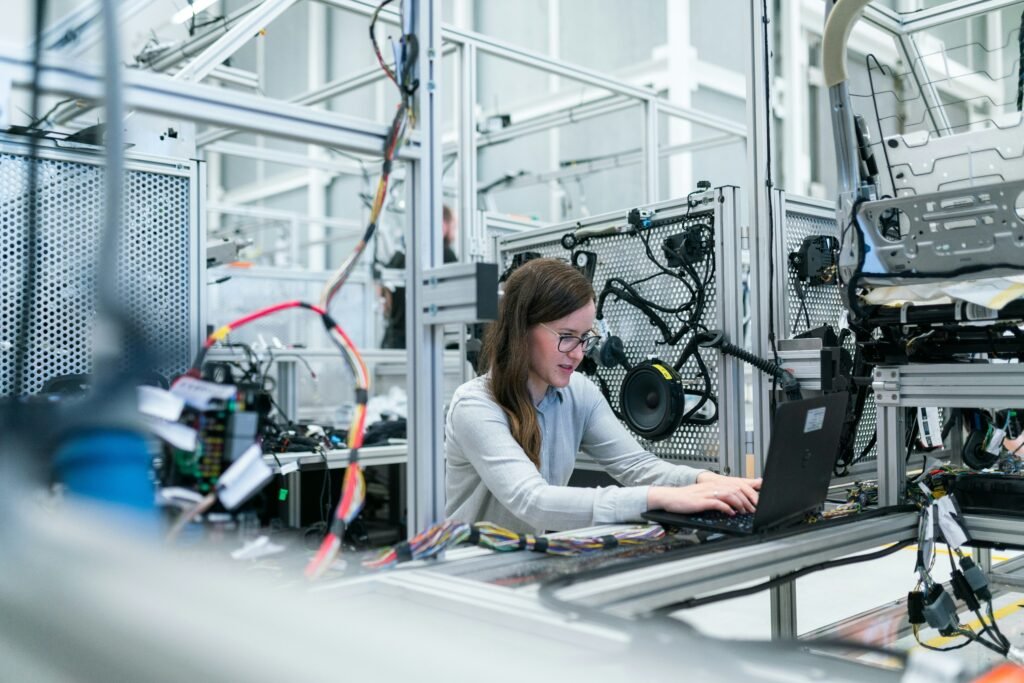Imagine a world where storage solutions are not just functional but also smart and intuitive. A world where advanced technology seamlessly integrates with your everyday life, making storage effortless and efficient. Welcome to the future of storage solutions – a revolution that promises to transform the way we organize and optimize our living spaces. With cutting-edge features and innovative design, these storage solutions are set to redefine the conventional understanding of what storage can do. Get ready to discover an entirely new level of convenience and ease as we delve into the world of advanced technology in storage.

This image is property of images.unsplash.com.
1. Cloud Storage
1.1 Centralized Data Storage
Cloud storage offers the convenience of centralized data storage, allowing you to store your files and data in one secure location. Instead of keeping your files on physical storage devices such as hard drives or USBs, you can store them on remote servers maintained by cloud storage providers. This centralized storage approach simplifies data management by eliminating the need to manually organize and track files across multiple devices.
1.2 Easy Accessibility
With cloud storage, your files are accessible from anywhere with an internet connection. Whether you’re at home, in the office, or on the go, you can access your files and data using any device, such as your computer, tablet, or smartphone. This easy accessibility ensures that you can retrieve or share files whenever and wherever you need them, enhancing your productivity and flexibility.
1.3 Scalability
Cloud storage offers the advantage of scalability by allowing you to easily expand your storage capacity as your needs grow. You can start with a small storage plan and gradually increase it as your data storage requirements increase. This scalability eliminates the need to invest in additional physical storage devices and provides a cost-effective solution for businesses and individuals who require flexible storage options.
2. Artificial Intelligence in Storage
2.1 Smart Organization and Categorization
Artificial intelligence (AI) is revolutionizing storage solutions by automating the organization and categorization of data. AI algorithms can analyze the content of your files and automatically categorize them based on keywords, topics, or even image recognition. This smart organization feature saves you time and effort by eliminating the need to manually organize and sort files, allowing you to focus on more important tasks.
2.2 Intelligent Search Capability
AI-powered storage solutions also offer intelligent search capabilities. Instead of spending countless hours searching for a specific file, AI algorithms can quickly and accurately retrieve the file you need based on keywords, metadata, or even content analysis. This intelligent search capability simplifies and accelerates the process of finding and accessing your files, ensuring that you can retrieve the information you need when you need it.
2.3 Predictive Analysis and Optimization
AI technology can analyze your storage usage patterns and make predictions about your future storage needs. By analyzing factors such as file types, access frequencies, and user behavior, AI-powered storage solutions can optimize your storage resources. This predictive analysis and optimization help you make informed decisions about storage capacity, ensuring that you have the right amount of storage available while minimizing costs and maximizing efficiency.

This image is property of images.unsplash.com.
3. Solid State Drives (SSDs)
3.1 Faster Data Access and Transfer Speeds
Solid State Drives (SSDs) have revolutionized data storage with their significantly faster access and transfer speeds compared to traditional hard disk drives (HDDs). With SSDs, you can access and transfer your files in a fraction of the time it would take with HDDs. This speed boost enhances your overall computing experience, allowing you to work more efficiently and effectively.
3.2 Enhanced Reliability and Durability
Unlike HDDs, which use spinning disks and mechanical components, SSDs have no moving parts. This absence of moving parts makes SSDs more resistant to physical shocks and vibrations, improving their reliability and durability. With SSDs, you can have peace of mind knowing that your data is better protected against accidental damage, ensuring the integrity and availability of your files.
3.3 Compact Size and Energy Efficiency
SSDs are more compact in size compared to HDDs, making them ideal for devices with limited space, such as laptops and ultrabooks. Their compact size also contributes to energy efficiency, as SSDs consume less power than HDDs. This energy efficiency not only reduces your carbon footprint but also extends the battery life of your portable devices, allowing you to work longer without needing to recharge.
4. Network-Attached Storage (NAS)
4.1 Centralized Data Storage and Backup
Network-Attached Storage (NAS) provides a centralized storage solution for multiple devices connected to a network. With NAS, you can store and backup your files in one location accessible to all devices on the network. This centralized data storage and backup capability ensure that your files are securely stored and easily retrievable, minimizing the risk of data loss and streamlining the file management process.
4.2 Easy File Sharing and Collaboration
NAS enables seamless file sharing and collaboration among users on the network. By granting appropriate access permissions, you can share files with colleagues, clients, or family members and collaborate on projects without the need for physical file transfers. This easy file sharing and collaboration feature improve communication and productivity, particularly in remote work settings or distributed teams.
4.3 Redundancy and Fault Tolerance
NAS systems often incorporate redundancy and fault tolerance mechanisms, such as RAID (Redundant Array of Independent Disks), to ensure data integrity and availability. By distributing data across multiple drives, NAS can tolerate drive failures without the loss of data. This redundancy and fault tolerance feature provide an added layer of protection to your stored files, safeguarding them against hardware failures and minimizing the risk of data loss.

This image is property of images.unsplash.com.
5. Virtualization of Storage
5.1 Efficient Utilization of Storage Resources
Virtualization of storage involves consolidating multiple physical storage devices into a virtual storage pool. This virtual storage pool can be allocated and shared among multiple users or virtual machines, optimizing the utilization of storage resources. By avoiding underutilization and overprovisioning, storage virtualization helps reduce costs and improve efficiency in data storage environments.
5.2 Simplified Management and Provisioning
Storage virtualization simplifies storage management and provisioning tasks by providing a single interface for administering and allocating storage resources. Instead of managing individual storage devices, virtualization allows you to centrally manage and allocate storage space based on the needs of specific users or applications. This simplified management and provisioning approach streamline administrative tasks and enhance operational efficiency.
5.3 Flexibility and Scalability
Virtualized storage offers flexibility and scalability, allowing you to adapt to changing storage requirements easily. You can dynamically resize storage allocations, add or remove storage devices, and migrate data between storage tiers without disrupting services or data accessibility. This flexibility and scalability enable you to optimize storage resources efficiently and effectively address evolving storage demands.
6. Data Compression and Deduplication
6.1 Reduced Storage Space Requirement
Data compression and deduplication technologies reduce the storage space required for your files and data. Data compression algorithms compress files by removing redundancies and encoding data more efficiently, resulting in smaller file sizes. Deduplication eliminates duplicate copies of data, storing only one instance of each unique piece of data. By applying these techniques, you can significantly reduce your storage space requirement, allowing you to store more data using less physical storage.
6.2 Faster Data Transfer and Backup
Data compression and deduplication also contribute to faster data transfer and backup speeds. Smaller file sizes resulting from data compression require less time to transfer or backup, enhancing data transfer efficiency. Deduplication reduces the amount of data that needs to be transferred or backed up, further accelerating the process. This faster data transfer and backup capability save valuable time and resources, improving overall productivity.
6.3 Cost Savings
Data compression and deduplication not only save storage space and improve data transfer efficiency but also result in cost savings. By reducing the amount of physical storage required, you can minimize the need for purchasing additional storage devices, leading to cost savings in terms of hardware investment. Additionally, the reduced data footprint lowers costs associated with data transfer, backup, and maintenance, contributing to overall cost-effectiveness in storage solutions.

This image is property of images.unsplash.com.
7. Internet of Things (IoT) Enabled Storage Solutions
7.1 Smart Monitoring and Management of Storage Devices
IoT-enabled storage solutions leverage the connectivity and intelligence of IoT devices to monitor and manage storage devices. With IoT sensors and connectivity, you can remotely monitor the health, performance, and utilization of your storage devices. This smart monitoring capability enables proactive maintenance and troubleshooting, ensuring optimal storage performance and minimizing downtime.
7.2 Real-time Data Collection and Analysis
IoT-enabled storage solutions enable real-time data collection and analysis, providing valuable insights into storage operations and usage patterns. By continuously collecting data from connected storage devices, IoT technologies can analyze the data and generate actionable insights. These insights can help optimize storage capacity planning, improve resource allocation, and enhance overall storage efficiency.
7.3 Enhanced Security and Privacy
IoT-enabled storage solutions integrate advanced security features to protect your data. With IoT technologies, you can implement secure authentication and encryption mechanisms to safeguard your stored files from unauthorized access or tampering. Additionally, IoT-enabled storage solutions enable granular access controls, allowing you to define and enforce fine-grained permissions for individual users or devices. This enhanced security and privacy ensure the confidentiality and integrity of your stored data.
8. Quantum Storage Technologies
8.1 High-Speed Data Access and Transfer
Quantum storage technologies leverage the principles of quantum mechanics to enable high-speed data access and transfer. Quantum storage devices can provide significantly faster data retrieval and transfer speeds compared to traditional storage technologies. This high-speed capability accelerates data-intensive processes and enhances overall system performance.
8.2 Massive Data Capacity and Long-Term Storage
Quantum storage technologies offer unprecedented data capacity and long-term storage capabilities. Quantum storage devices can store massive amounts of data in a compact form factor, enabling high-density storage solutions. Additionally, quantum storage has the potential for long-term data retention, making it an attractive option for archiving and preserving large volumes of data over extended periods.
8.3 Unparalleled Data Security
Quantum storage technologies offer unparalleled data security through the use of quantum cryptography. Quantum cryptography utilizes the principles of quantum mechanics to secure data transmission and storage against eavesdropping and tampering attempts. The inherent properties of quantum mechanics, such as quantum key distribution, ensure the confidentiality and integrity of your stored data, providing a highly secure storage solution.

This image is property of images.unsplash.com.
9. Blockchain-based Storage Solutions
9.1 Decentralized Data Storage and Encryption
Blockchain-based storage solutions offer decentralized data storage and encryption capabilities. Instead of relying on a central authority or storage provider, blockchain-based storage distributes data across a network of interconnected nodes. This decentralized approach enhances data resilience and security, as data is not stored in a single location or controlled by a single entity. Additionally, blockchain-based storage solutions employ robust encryption techniques to protect data from unauthorized access.
9.2 Immutable and Tamper-Proof Data
Blockchain technology ensures the immutability and tamper-proof nature of stored data. Once data is added to the blockchain, it becomes part of an unalterable chain of blocks, making it practically impossible to modify or erase. This immutability feature ensures data integrity and creates a verifiable audit trail, making blockchain-based storage solutions suitable for industries with regulatory or compliance requirements.
9.3 Enhanced Data Privacy and Control
Blockchain-based storage solutions provide enhanced data privacy and control. By leveraging cryptographic protocols and decentralized mechanisms, blockchain-based storage enables individuals and organizations to have greater control over their data. Users can define who can access their data and under what conditions, ensuring privacy and data sovereignty. This enhanced privacy and control empower users to protect their data and determine how it is used.
10. Hybrid Storage Architectures
10.1 Optimal Combination of Different Storage Technologies
Hybrid storage architectures combine multiple storage technologies to create an optimal storage solution. By leveraging the strengths of each technology, hybrid storage architectures can address specific storage requirements efficiently. For example, a hybrid storage architecture may combine SSDs for high-performance and frequently accessed data with HDDs for cost-effective long-term storage.
10.2 Cost-Effectiveness and Performance Optimization
Hybrid storage architectures offer cost-effectiveness and performance optimization benefits. By utilizing cost-effective storage technologies for less frequently accessed data and high-performance storage technologies for frequently accessed data, hybrid architectures minimize costs while ensuring optimal performance. This cost-performance balance optimizes storage resource utilization and helps organizations achieve their storage goals within budget.
10.3 Seamless Integration and Data Mobility
Hybrid storage architectures enable seamless integration and data mobility between different storage technologies. Data can be easily moved or tiered between different storage tiers based on usage patterns, performance requirements, or cost considerations. This data mobility ensures that data is stored in the most appropriate storage technology at any given time, maximizing performance and efficiency while catering to changing storage demands.
In conclusion, advanced storage technologies are revolutionizing the way we store and manage our data. From cloud storage providing centralized and accessible data storage to the smart features offered by artificial intelligence, these technologies enhance efficiency and productivity. Solid state drives offer faster speeds and improved reliability, while network-attached storage provides centralized storage and collaboration capabilities. Virtualization optimizes storage resource utilization, and data compression and deduplication save space and costs. IoT-enabled storage solutions offer smart monitoring and enhanced security, while quantum storage and blockchain-based solutions provide unprecedented storage capabilities and security. Finally, hybrid storage architectures combine various technologies for optimal performance and cost-effectiveness. With these advanced storage solutions, you can embrace the future of data storage and enhance your productivity and efficiency.
